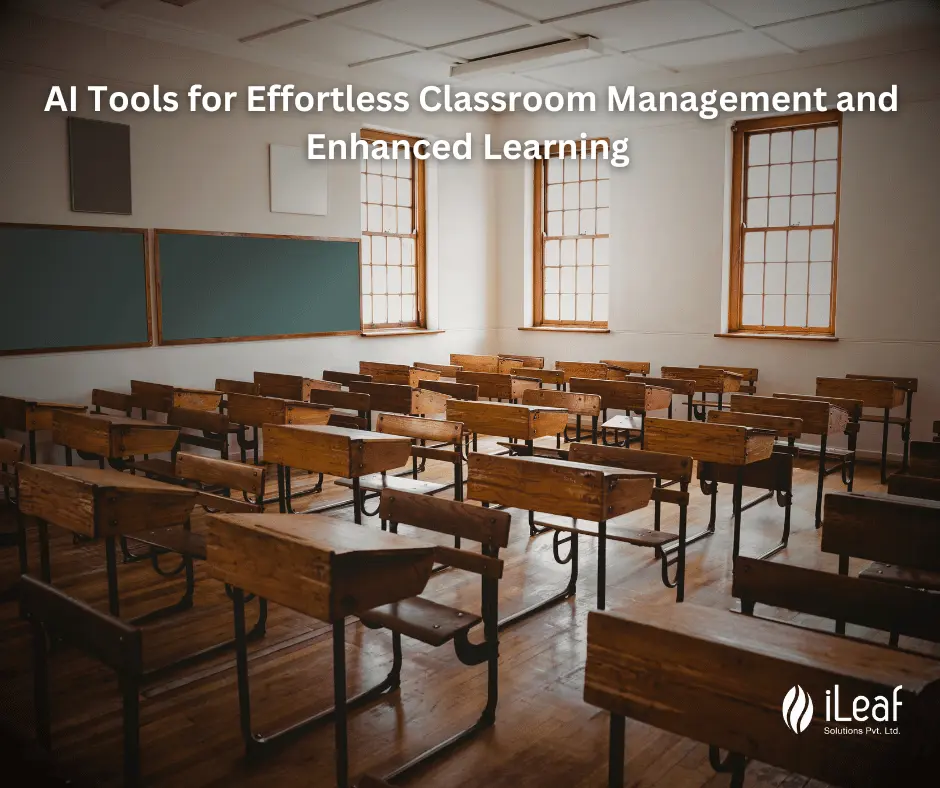Empowering Teachers with AI Tools for Streamlining Classroom Management

In the educational realm, AI applications are broad and diverse. They encompass everything from personalized learning experiences and adaptive tutoring to administrative automation and enhanced data analysis. The marriage of AI with education holds the promise of a more efficient, personalized, and inclusive learning environment for students and educators alike.
b. Importance of Classroom Management for Effective Teaching and Learning
Classroom management serves as the backbone of any successful educational endeavor. It refers to the strategies, techniques, and skills employed by educators to create an environment conducive to effective teaching and learning. Effective classroom management cultivates a space where students can engage with the subject matter, collaborate with peers, and thrive academically.
A well-managed classroom allows educators to focus on delivering high-quality instruction, tailoring lessons to meet individual student needs, and promoting a positive and productive atmosphere. Conversely, poor classroom management can impede learning, hinder student participation, and ultimately undermine the educational experience.
c. Transition to Discussing AI's Role in Enhancing Classroom Management
With the understanding of the pivotal role classroom management plays in education, it becomes evident that enhancing this aspect is of paramount importance. Enter Artificial Intelligence (AI), a technological marvel that has the potential to revolutionize classroom management. By integrating AI-powered tools and solutions, educators can streamline administrative tasks, gain valuable insights into student engagement and performance, and tailor teaching approaches to the unique needs of each student.
In this blog post, we will delve into the ways AI is being utilized to optimize classroom management, creating an environment where educators can focus more on teaching, students can thrive, and the educational landscape can be transformed for the better.
II. Understanding Classroom Management
Classroom management is the practice of organizing, directing, and controlling the resources, space, and time within a classroom to create an effective learning environment. It encompasses a set of strategies and techniques that teachers employ to ensure an atmosphere conducive to teaching and learning. Effective classroom management is vital for the overall success of both students and educators, as it sets the stage for a positive and productive educational experience.
a. Definition and Significance of Classroom Management
Classroom management involves establishing clear expectations, maintaining a well-organized physical and emotional space, and implementing strategies that promote engagement, participation, and cooperation among students. It is about creating a structured environment that allows for effective teaching and learning to take place. Through proper classroom management, teachers aim to minimize disruptions, maximize learning opportunities, and foster a sense of community and mutual respect.
b. Key Components of Effective Classroom Management
Establishing Clear Expectations and Rules: Setting clear guidelines and rules at the beginning of the school year creates a structured environment. Students know what behavior is expected of them, which contributes to a sense of order and predictability.
Building Positive Relationships: Fostering positive relationships with students promotes trust and respect. When students feel valued and understood, they are more likely to adhere to classroom expectations and actively engage in learning.
Creating a Stimulating Physical Environment: An organized and visually appealing classroom with well-arranged seating, learning materials, and displays can positively impact students' focus and engagement.
Utilizing Effective Instructional Strategies: Employing varied teaching techniques, incorporating interactive lessons, and adapting to different learning styles help maintain students' interest and motivation.
Implementing Fair and Consistent Discipline: Applying fair consequences for both positive and negative behavior encourages students to take responsibility for their actions while maintaining a respectful classroom atmosphere.
c. Challenges Faced by Educators in Traditional Classroom Settings
Educators often encounter numerous challenges in maintaining effective classroom management within traditional settings:
Diverse Student Needs: Students come from diverse backgrounds with varying abilities, interests, and learning styles, making it challenging to meet everyone's individual needs simultaneously.
Classroom Size: Large class sizes can make it difficult to provide personalized attention and manage student behavior effectively.
Student Engagement: Keeping students engaged and focused, especially with the prevalence of distractions like smartphones, is an ongoing challenge for educators.
Behavioral Issues: Addressing disruptive behavior and maintaining a positive classroom atmosphere in the face of behavioral challenges can be taxing.
Time Constraints: Balancing the need to cover curriculum requirements with the need for effective classroom management can be demanding, often leaving teachers feeling pressed for time.
III. AI-Powered Classroom Management Tools
a. Overview of AI Applications in Streamlining Classroom Management
Artificial Intelligence (AI) is revolutionizing the education sector by offering innovative solutions to age-old challenges. In the realm of classroom management, AI presents a diverse range of applications that significantly enhance the teaching and learning experience. These AI-powered tools leverage data analytics, machine learning, and natural language processing to optimize various aspects of classroom management.
b. Real-time Student Engagement Monitoring and Analysis
One of the most impactful AI applications in education is real-time student engagement monitoring and analysis. AI tools can now track students' interactions with digital learning platforms, analyze their behavior, and provide insights into their level of engagement. By identifying patterns and trends, educators can tailor their teaching strategies to capture and maintain students' attention.
Real-time monitoring involves tracking the time students spend on specific tasks, their participation in class discussions, and their interactions with educational materials. Advanced AI algorithms can even gauge the emotional state of students during online learning sessions, helping educators adapt their approach to optimize the learning environment.
Moreover, AI analytics can provide comprehensive reports, highlighting individual student performance, comprehension levels, and areas that may require additional support. This personalized insight enables teachers to intervene promptly, addressing challenges and fostering a more interactive and effective learning atmosphere.
c. Automated Administrative Tasks and Grading
AI streamlines administrative tasks for educators, allowing them to focus more on teaching and less on paperwork. Automated administrative tools can manage attendance records, schedule creation, assignment tracking, and grading systems. This automation saves valuable time and ensures accuracy in record-keeping.
In the traditional setting, grading a stack of assignments can be time-consuming. AI-powered grading systems use algorithms to evaluate assignments and provide instant feedback. Machine learning algorithms can be trained to recognize and assess various patterns, formats, and types of responses, providing consistent and timely feedback to students. Automated grading not only accelerates the feedback process but also enables teachers to identify common misconceptions or areas where students struggle. Armed with this data, educators can tailor their teaching strategies to clarify concepts and enhance comprehension.
IV. Personalized Learning Experience with AI
In the dynamic landscape of education, a one-size-fits-all approach no longer suffices. Recognizing the unique needs, strengths, and learning styles of each student is fundamental to fostering a successful academic journey. Artificial Intelligence (AI) plays a pivotal role in tailoring education to individual students, providing a personalized learning experience that maximizes their potential. Here's a closer look at how AI achieves this personalization:
a. Customizing Teaching Strategies with AI Insights
One of the remarkable aspects of AI in education is its ability to analyze vast amounts of data, offering valuable insights into student performance, preferences, and learning patterns. These insights empower educators to customize their teaching strategies for each student, ensuring that the material is presented in a manner that resonates best with them.
For instance, AI algorithms can assess a student's past performance, identifying areas of strength and weakness. If a student excels in visual learning, AI can suggest incorporating more visual aids or interactive lessons into their curriculum. On the other hand, if a student struggles with a specific topic, AI can recommend targeted resources or alternative teaching methods to reinforce understanding.
b. Adaptive Learning Platforms and their Impact on Student Progress
Adaptive learning platforms, driven by AI, are gaining traction for their ability to dynamically adjust the learning path based on individual student progress. These platforms provide personalized learning experiences by continuously assessing a student's performance and adapting the content and difficulty level accordingly.
As a student interacts with the platform, AI algorithms analyze their responses and engagement patterns. This analysis helps in fine-tuning the content, suggesting additional practice in challenging areas, or advancing to more complex topics if the student demonstrates mastery. Ultimately, this adaptability ensures optimal engagement, comprehension, and progress for each student.
c. Addressing Individual Student Needs through AI-Powered Tools
Students have diverse learning needs and preferences. Some may require additional assistance, while others may benefit from advanced challenges. AI-powered tools can cater to these needs effectively by providing individualized support and opportunities for growth.
For instance, AI can assist in creating individualized education plans (IEPs) for students with special needs. By analyzing their learning patterns and requirements, AI algorithms can suggest appropriate accommodations, modifications, or interventions to optimize their learning experience and outcomes.
V. Future Prospects and Trends
a. Anticipated Advancements and Trends in AI for Classroom Management
Artificial Intelligence (AI) in the realm of education is rapidly evolving, and the future holds promising advancements that will significantly impact classroom management. Predictive analytics and machine learning algorithms will play a pivotal role in identifying patterns in student behavior, enabling educators to foresee potential issues and customize their teaching approaches. AI-powered classroom management tools will provide actionable insights, empowering teachers to make informed decisions for a more efficient and effective learning environment.
Moreover, natural language processing (NLP) capabilities within AI will enable better understanding and interpretation of student responses and interactions. This will facilitate nuanced analysis of student comprehension levels and learning styles, allowing teachers to tailor their instructional methods accordingly. AI algorithms will continuously improve, adapting to the unique needs of each student, further enhancing the personalized learning experience.
b. Integration of Emerging Technologies like Virtual Reality (VR) and Augmented Reality (AR)
The integration of virtual reality (VR) and augmented reality (AR) into educational settings is a burgeoning trend that holds immense potential for transforming classroom management. VR and AR technologies can immerse students in interactive and simulated learning environments, providing a hands-on and engaging educational experience. From virtual field trips to historical sites to interactive 3D models of complex concepts, these technologies offer a dynamic and stimulating way to augment traditional teaching methods.
In the realm of classroom management, VR and AR can revolutionize disciplinary measures by creating virtual scenarios that allow students to experience the consequences of their actions in a safe and controlled environment. This innovative approach can instill a sense of responsibility and empathy among students while minimizing disruptions in the physical classroom.
c. Potential Impact on Education and the Teaching Profession
The potential impact of AI and the integration of emerging technologies like VR and AR on education and the teaching profession is profound. With AI automating administrative tasks and providing valuable insights, teachers can dedicate more time to personalized instruction and fostering critical thinking skills in students. This shift will redefine the role of educators from traditional lecturers to mentors and facilitators of enriched learning experiences.
VI. Conclusion
In this era of rapid technological advancement, embracing artificial intelligence (AI) has proven to be a game-changer, especially in the realm of education. The infusion of AI-powered tools and technologies into the classroom setting has revolutionized the way educators manage their classrooms and, consequently, the learning experiences of their students.
a. Recap of the Benefits of AI in Classroom Management
As discussed throughout this blog, the benefits of utilizing AI in classroom management are manifold. AI tools enable real-time student engagement monitoring and analysis, automating administrative tasks and grading, and providing a personalized learning experience. By leveraging AI, educators can tailor teaching strategies to meet individual student needs, resulting in enhanced academic performance and a deeper understanding of the subjects being taught. Additionally, AI fosters efficient communication and collaboration among stakeholders, ensuring a more cohesive and informed learning environment.
b. Encouragement for Educators to Embrace AI for Enhanced Teaching Experiences
To keep up with the evolving landscape of education, it is essential for educators to embrace the potential of AI. The integration of AI-powered tools empowers educators to focus more on meaningful interactions with students and devise effective teaching strategies, while routine administrative tasks are efficiently handled by AI. By adopting AI, educators can unlock a world of possibilities, enabling them to provide personalized attention to each student and cultivate a dynamic and engaging learning atmosphere.
c. Closing Thoughts on the Transformative Power of AI in Education
In conclusion, the transformative power of AI in education is poised to reshape the future of learning. The innovative applications of AI, including adaptive learning platforms, automated grading systems, and AI-driven content creation, hold immense promise for educational institutions and educators alike. As AI continues to evolve and become more integrated into the fabric of education, it will catalyze a paradigm shift, enhancing the quality of education and preparing students for the challenges of a rapidly changing world.














